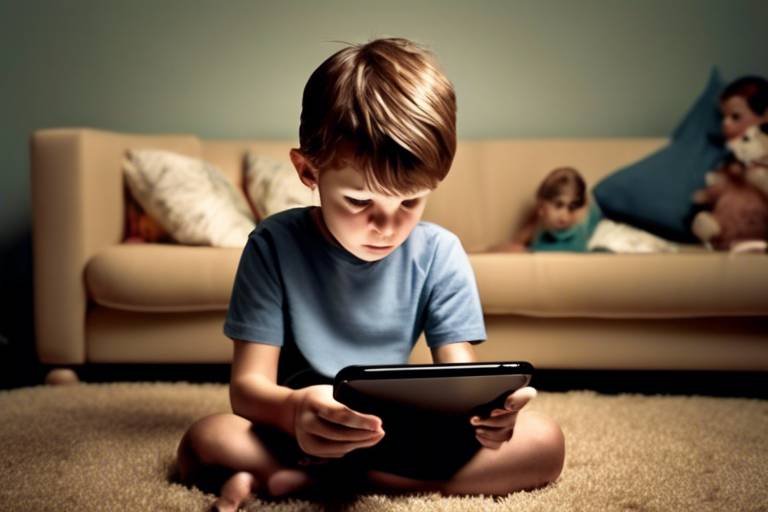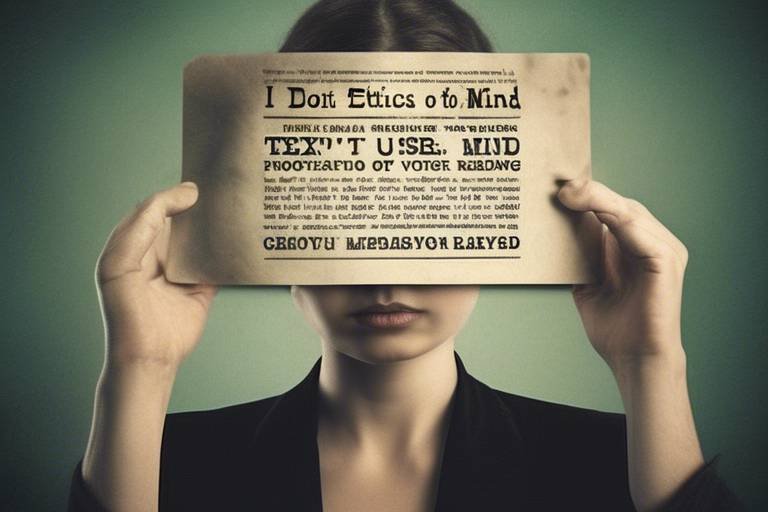Unveiling the Morality of Screen Time
In today’s fast-paced digital world, screen time has become an integral part of our daily lives. From scrolling through social media feeds to binge-watching our favorite shows, the hours spent in front of screens can easily accumulate without us even realizing it. But have you ever stopped to think about the ethical implications of this phenomenon? As we dive into the morality of screen time, we’ll explore its effects on mental health, social interactions, and the responsibilities both users and content creators hold. It’s a complex issue that warrants our attention, especially in an age where digital devices are practically extensions of ourselves.
So, what exactly constitutes screen time? It encompasses a wide range of activities, including watching television, using smartphones, playing video games, and working on computers. In fact, studies indicate that the average person spends around 7 to 10 hours a day glued to some type of screen. This staggering statistic sets the stage for a deeper discussion on how this screen-centric lifestyle influences our lives. Are we merely passive consumers of content, or are we actively engaging with the digital world? Understanding the nuances of screen time is crucial as we examine its moral dimensions.
The relationship between screen time and mental health is a hot topic in today’s society. Research has shown that excessive screen time can lead to serious psychological issues such as anxiety and depression. For instance, a study conducted by the American Psychological Association found that individuals who spend more than 3 hours a day on social media are at a higher risk of experiencing feelings of loneliness and inadequacy. It’s alarming to think that our screens, which are meant to connect us, can sometimes do the opposite. The implications are particularly pronounced across different age groups, prompting us to ask: how is screen time shaping our mental health landscape?
When it comes to children, the stakes are even higher. Kids today are growing up in a digital age where screens are ubiquitous, and their unique vulnerabilities make them particularly susceptible to the negative effects of excessive screen time. Studies suggest that too much screen exposure can lead to developmental issues, impacting their social skills, behavior, and emotional well-being. This raises an important question for parents: how can we strike a balance between allowing our children to engage with technology and ensuring their healthy development?
To help parents navigate this tricky terrain, here are some practical tips:
- Set Screen Time Limits: Establish clear boundaries on how much time your child can spend on screens each day.
- Encourage Outdoor Activities: Promote physical activities that don’t involve screens, like sports or outdoor play.
- Be a Role Model: Demonstrate healthy screen habits yourself; children often mimic their parents' behavior.
By implementing these guidelines, parents can foster a healthier relationship between their children and technology, ensuring that screen time doesn't overshadow real-world interactions.
The long-term consequences of excessive screen time on children’s cognitive and social development cannot be ignored. Research indicates that overexposure to screens can hinder attention spans, affect academic performance, and lead to social isolation. As children grow, the habits they form now can follow them into adulthood, shaping their relationships and mental health for years to come. This emphasizes the importance of mindful consumption of digital content, not just for children, but for all of us.
Screen time doesn’t just affect our mental health; it also has a profound impact on our social interactions and relationships. While technology can enhance communication, it can also create barriers. Think about it: when was the last time you were out with friends and everyone was glued to their phones instead of engaging in conversation? It’s a double-edged sword. On one hand, screens can help us connect with people across the globe, but on the other hand, they can erode the quality of face-to-face interactions.
With great power comes great responsibility, and this rings especially true for content creators. Those who produce digital content have an ethical obligation to consider the well-being of their audiences. The messages and values conveyed through their work can significantly influence viewers, particularly younger audiences who are more impressionable. So, how can content creators ensure they are fostering a positive digital environment?
Content that promotes healthy screen time habits and positive messages can make a world of difference. For example, educational videos that encourage creativity and critical thinking can inspire viewers to engage with technology in a constructive way. By prioritizing ethics in their productions, creators can help shape a healthier digital landscape.
It’s equally important to ensure that content is age-appropriate. Regulations play a crucial role in protecting younger viewers from harmful material. Advocating for a safer digital environment not only benefits children but also fosters a culture of responsibility among content creators. As we navigate this digital age, the collective effort to create and consume content mindfully is essential.
1. How much screen time is considered too much for children?
Experts recommend limiting screen time for children to no more than 1-2 hours per day, depending on their age and activity level.
2. Can screen time have positive effects?
Yes, when used wisely, screen time can provide educational benefits, enhance creativity, and facilitate social connections.
3. What are some signs that screen time is affecting mental health?
Signs include increased anxiety, mood swings, withdrawal from social interactions, and diminished academic performance.
4. How can parents monitor their children's screen time?
Parents can use apps to track usage, set time limits, and engage in open discussions about online activities.
5. What role do content creators play in promoting healthy screen habits?
Content creators can prioritize ethical practices by producing engaging, educational, and age-appropriate content that encourages positive screen time habits.

Understanding Screen Time
In our fast-paced, technology-driven world, screen time has become an integral part of our daily lives. But what does screen time really mean? Essentially, it refers to the amount of time spent using devices that have screens, including smartphones, tablets, computers, and televisions. As we dive deeper into this topic, it’s crucial to recognize that screen time is not just a single entity; it encompasses various activities such as browsing social media, playing video games, watching movies, or even engaging in educational content. The average person spends approximately 7 hours a day glued to a screen, and for children, this number can be even higher, leading to a growing concern about the implications of such extensive usage.
To truly understand the impact of screen time, we need to dissect its components. For example, consider the difference between passive and active screen time. Passive screen time involves activities like watching TV or scrolling through social media feeds, where engagement is minimal. In contrast, active screen time includes video gaming or interactive learning, which can foster creativity and problem-solving skills. However, the line between beneficial and detrimental screen time can often blur, making it essential for users to evaluate how they spend their time on screens.
Moreover, the context in which screen time occurs plays a significant role in its effects. For instance, using screens for educational purposes can be immensely beneficial, especially when it comes to remote learning and access to information. On the other hand, excessive passive consumption can lead to feelings of isolation and contribute to mental health issues. It’s a double-edged sword, and understanding this complexity is vital as we navigate our digital lives.
In addition, it's important to recognize the demographic differences in screen time usage. Here’s a brief overview:
| Age Group | Average Daily Screen Time | Common Activities |
|---|---|---|
| Children (2-12 years) | 4-6 hours | Gaming, watching cartoons, educational apps |
| Teens (13-19 years) | 7-9 hours | Social media, gaming, streaming |
| Adults (20-64 years) | 6-8 hours | Work, social media, streaming |
| Seniors (65+ years) | 3-5 hours | Video calls, news, streaming |
This table illustrates not only the average screen time across different age groups but also the common activities associated with each demographic. It’s evident that as age increases, the nature of screen time usage tends to shift, with younger individuals often gravitating towards gaming and social media, while older adults may prefer news and video calls.
Ultimately, understanding screen time is about more than just tracking hours; it’s about recognizing how these hours are spent and the potential consequences of our digital habits. As we proceed with this discussion, we’ll explore the implications of screen time on mental health, social interactions, and the responsibilities that come with being both a user and a creator in this digital age.

Impact on Mental Health
In today’s fast-paced world, where screens dominate our daily lives, it’s crucial to understand the profound impact that screen time can have on our mental health. Studies have shown a clear connection between excessive screen use and a range of psychological issues, including anxiety, depression, and even feelings of loneliness. But what exactly is it about our screens that can lead to such detrimental effects? Is it the content we consume, the time we spend, or perhaps both?
Research indicates that the average person spends over 7 hours a day in front of screens, whether it’s for work, social media, or entertainment. This staggering number raises questions about how this digital engagement affects our emotional well-being. For instance, a study published in the journal Psychological Science found that individuals who spent more time on social media reported higher levels of anxiety and depression. Why? Because while we might think that scrolling through our feeds connects us with the world, it often leads to comparison, envy, and feelings of inadequacy.
Moreover, the nature of the content we consume plays a significant role in shaping our mental health. Engaging with positive, uplifting content can foster a sense of community and belonging, while exposure to negative news or toxic interactions can have the opposite effect. It’s like choosing between a warm hug and a cold shoulder—one nourishes your soul, while the other can leave you feeling drained.
When it comes to children, the stakes are even higher. Kids are particularly vulnerable to the impacts of screen time, and the consequences can be long-lasting. Excessive screen exposure can hinder their emotional development and affect their ability to form healthy relationships. Imagine a child who spends more time interacting with a screen than with peers; they may struggle with social cues and emotional intelligence, which are crucial for building connections in the real world.
For parents, navigating the digital landscape can feel overwhelming. Here are some practical tips to ensure a healthy balance:
- Set Limits: Establish daily screen time limits to encourage breaks and outdoor play.
- Be a Role Model: Demonstrate healthy screen habits by limiting your own usage.
- Encourage Offline Activities: Foster interests that don’t involve screens, like sports, reading, or arts and crafts.
- Engage Together: Watch shows or play games as a family to promote shared experiences.
It’s important to recognize that the effects of excessive screen time can extend into adulthood. Children who grow up with high screen exposure may face challenges such as reduced attention spans, impaired social skills, and even difficulties in academic performance. As they transition into adulthood, these issues can manifest as chronic stress, anxiety disorders, or difficulties in maintaining relationships. Therefore, mindful consumption of digital content is not just a parental responsibility; it’s a societal obligation.
In conclusion, while screens are an integral part of modern life, it’s essential to be aware of their potential impact on mental health. By fostering open conversations about screen time, encouraging positive content, and setting boundaries, we can create a healthier relationship with our devices. After all, it’s not just about the time we spend on screens, but the quality of that time that truly matters.
- How much screen time is considered too much? While recommendations vary, many experts suggest limiting recreational screen time to no more than 2 hours per day for adults and even less for children.
- Can screen time have positive effects? Yes! Engaging with educational content or maintaining connections with friends and family through video calls can be beneficial.
- What are some signs of excessive screen time? Signs may include irritability, difficulty concentrating, disrupted sleep patterns, and withdrawal from real-life social interactions.

Children and Screen Time
When it comes to , the conversation can get quite heated. We live in an age where digital devices are as common as toys, and while screens can offer educational content and entertainment, they also present unique challenges. Children are like sponges, soaking up information and experiences, but what happens when the majority of their experiences come from a glowing screen? The impact is profound and multifaceted.
Research indicates that excessive screen time can significantly affect a child's development. For instance, studies have shown that children who spend more than two hours a day on screens are at a higher risk of developing behavioral problems. The digital world can be overwhelming; it often distorts reality, leading to issues with emotional regulation and social skills. Imagine a child learning to interact with others primarily through a device, missing out on the subtleties of face-to-face communication. It’s like trying to learn to swim by watching videos instead of jumping into the water!
Moreover, the type of content consumed is just as important as the amount of time spent. Engaging with educational programs can be beneficial, but mindless scrolling through social media or playing violent video games can have adverse effects. Parents need to be vigilant and proactive about the content their children are exposed to. Here are some critical areas to consider:
- Emotional Development: Excessive screen time has been linked to increased feelings of anxiety and depression in children. The constant barrage of curated images and lifestyles can create unrealistic expectations and feelings of inadequacy.
- Physical Health: Long hours in front of a screen can lead to a sedentary lifestyle, contributing to obesity and other health issues. It’s crucial to encourage physical activity alongside screen time.
- Sleep Disruption: The blue light emitted from screens can interfere with sleep patterns, leading to fatigue and irritability. A well-rested child is far more likely to thrive emotionally and socially.
So, what can parents do to navigate this digital landscape? Setting boundaries is key. Experts recommend creating a family media plan that includes guidelines on when and how long children can use screens. This not only helps in managing their time but also encourages them to engage in other activities, like reading or playing outside. Think of it as a balancing act—too much weight on one side and the whole thing tips over.
In conclusion, while screens are an integral part of modern life, it’s essential to approach them with caution when it comes to children. By fostering a healthy relationship with technology, parents can help their kids enjoy the benefits of digital engagement while minimizing the risks. It’s all about finding that sweet spot where technology enhances life rather than detracts from it.
Q: How much screen time is appropriate for children?
A: The American Academy of Pediatrics recommends that children aged 2 to 5 should have no more than one hour of high-quality programming per day, while children younger than 18 months should avoid screen time, except for video chatting.
Q: What are some signs that my child is spending too much time on screens?
A: Look for signs such as irritability when not using a device, trouble sleeping, declining academic performance, or a lack of interest in activities they once enjoyed.
Q: How can I encourage my child to engage in non-screen activities?
A: Introduce fun alternatives like board games, outdoor sports, arts and crafts, or family outings. Setting a good example by limiting your own screen time can also motivate them.

Guidelines for Parents
As parents, navigating the digital landscape can feel like walking through a maze. With screens becoming an integral part of our children's lives, it’s essential to set clear guidelines that foster a healthy relationship with technology. Here are some practical strategies to help you manage your children's screen time effectively, ensuring they reap the benefits while minimizing potential harms.
First and foremost, communication is key. Talk to your children about the content they are consuming and the time they spend on screens. Encourage open discussions about their online experiences, which can help you gauge their understanding and feelings regarding digital interactions. This way, you can address any concerns they might have and guide them toward making better choices.
Another important aspect is to establish screen time limits. The American Academy of Pediatrics recommends that children aged 2 to 5 should have no more than one hour of high-quality programming each day, while children younger than 18 months should avoid screen time altogether, except for video chatting. For older kids, it’s crucial to set boundaries that fit your family's lifestyle. Consider creating a family media plan that outlines when and how screens can be used. This could include:
- Designating certain times of the day for screen use, such as after homework is completed.
- Encouraging tech-free zones, like during family meals or in bedrooms.
- Involving your children in setting these rules to promote accountability.
Moreover, lead by example. Children often mimic their parents' behaviors, so if you want them to have a balanced approach to screen time, it’s essential that you model it. Show them how to engage with technology mindfully by limiting your own screen time during family activities. This creates a culture of moderation within your household.
Lastly, make sure to promote alternative activities that don’t involve screens. Encourage your children to participate in outdoor play, reading, or arts and crafts. These activities not only stimulate their creativity but also provide valuable opportunities for social interaction and physical activity, which are crucial for their overall development.
By implementing these guidelines, you can help your children develop a healthy relationship with technology. Remember, it’s not about eliminating screens entirely but rather ensuring that their use is balanced and enriching. With your guidance, they can learn to navigate the digital world responsibly, equipping them with the skills they need for a lifetime.
Q1: How can I monitor my child's screen time without invading their privacy?
A1: Use apps or built-in features on devices to track usage without being intrusive. Discuss openly with your child about the importance of monitoring for their safety.
Q2: What should I do if my child is addicted to screens?
A2: Start by gradually reducing screen time and replacing it with engaging offline activities. Seek professional help if necessary, as addiction can have serious implications.
Q3: Are there specific types of content I should encourage my child to watch?
A3: Yes! Look for educational programs or those that promote positive values and critical thinking. Quality content can enhance learning and provide valuable lessons.

Long-term Effects on Development
The long-term effects of excessive screen time on children's development are becoming a pressing concern for parents, educators, and mental health professionals alike. As screens have become ubiquitous in our lives, the implications of prolonged exposure to digital devices can no longer be brushed aside. Studies suggest that children who spend excessive time in front of screens may experience significant impacts on their cognitive development, social skills, and even their emotional well-being.
One of the most alarming aspects is the potential for diminished cognitive abilities. Research indicates that children who engage in excessive screen time may struggle with attention spans, problem-solving skills, and critical thinking. This is particularly concerning as these skills are foundational for academic success and personal growth. Moreover, when children are glued to screens, they often miss out on crucial opportunities for real-world learning—the kind that happens through exploration, play, and interaction with peers.
Socially, the implications are equally profound. Children who spend more time on screens may find it challenging to develop interpersonal skills. They might struggle with reading non-verbal cues, which are essential for effective communication. Imagine a child who has spent hours playing video games or scrolling through social media; when it comes time to interact face-to-face, they might feel awkward or unsure. This lack of practice in real-life scenarios can lead to a sense of isolation and difficulties in forming meaningful relationships.
Additionally, emotional development can be hindered by excessive screen time. Children are at a critical stage where they learn to navigate their feelings and understand the emotions of others. However, when they substitute screen interactions for real-life connections, they may not develop the necessary emotional intelligence. This can lead to issues such as anxiety and depression, as children find it challenging to cope with their feelings when they are not equipped with the right tools.
To provide a clearer picture, let's look at some potential long-term effects summarized in the table below:
| Long-term Effects | Description |
|---|---|
| Cognitive Delays | Reduced attention span and critical thinking skills. |
| Poor Social Skills | Difficulties in understanding non-verbal cues and forming relationships. |
| Emotional Challenges | Increased risk of anxiety and depression due to lack of real-world interactions. |
In light of these findings, it is crucial for parents to be proactive in managing their children's screen time. Encouraging a balanced approach that includes outdoor activities, face-to-face interactions, and creative play can significantly mitigate these long-term effects. By fostering an environment where children can thrive both online and offline, parents can help ensure that their children grow into well-rounded individuals capable of navigating the complexities of life.
- How much screen time is considered excessive for children? Experts recommend that children aged 2 to 5 should have no more than one hour of high-quality programming per day, while children aged 6 and older should have consistent limits on the amount of time spent using screens.
- What are some signs that screen time is affecting my child's development? Look out for signs such as difficulty concentrating, withdrawal from social interactions, or increased irritability when screen time is limited.
- How can I encourage my child to engage in more offline activities? Introduce fun alternatives like outdoor sports, arts and crafts, or family game nights to create a balanced lifestyle.

Social Interactions and Relationships
In today’s fast-paced digital world, the way we interact with one another has dramatically evolved, largely due to the omnipresence of screens. From smartphones to tablets and laptops, our screens have become windows to a vast universe of communication. But have you ever stopped to think about how this constant connection affects our social interactions and relationships? While technology has made it easier to stay in touch with friends and family, it has also created a paradox where we are simultaneously more connected yet more isolated.
On one hand, social media platforms and messaging apps allow us to reach out to loved ones across the globe with just a few taps. We can share our lives in real-time, celebrate milestones, and provide support during tough times. However, this digital engagement often replaces face-to-face interactions, leading to a decline in the depth of our relationships. It’s easy to send a quick text or emoji, but how often do we sit down for a meaningful conversation? The convenience of screens can sometimes mask the need for genuine emotional connection, leaving us feeling empty.
Moreover, excessive screen time can alter our communication skills. Have you noticed how some people struggle to maintain eye contact during conversations, often glancing at their phones instead? This behavior can be detrimental to building trust and understanding in relationships. As we become more accustomed to communicating through screens, we might lose the ability to read non-verbal cues and engage in active listening. The result? Misunderstandings and conflicts that could have been avoided with face-to-face dialogue.
Interestingly, while screens can foster connections, they can also create barriers. The phenomenon of “social media envy” is real; scrolling through curated posts can lead to feelings of inadequacy and loneliness. When we compare our behind-the-scenes to someone else's highlight reel, it’s easy to feel left out or unworthy. This can strain relationships, as we may withdraw from friends or family, believing they are living a better life than we are. The key is to remember that what we see online is often a distorted version of reality.
In addition to these emotional impacts, the way we communicate through screens can influence our social skills. For instance, a study highlighted in the Journal of Social and Personal Relationships found that individuals who spend more time online tend to have lower levels of empathy and face challenges in interpreting emotions. This decline in social acumen can have long-term repercussions on our ability to form meaningful relationships.
So, how can we strike a balance? Here are a few tips to cultivate healthier relationships amidst our screen-centric lives:
- Prioritize Face-to-Face Interactions: Make a conscious effort to meet friends and family in person. Whether it's a coffee date or a family dinner, these moments foster deeper connections.
- Set Boundaries: Designate screen-free times during your day, such as during meals or before bed, to encourage more meaningful interactions.
- Be Mindful of Your Usage: Reflect on how screen time affects your mood and relationships. If you find yourself feeling disconnected, it might be time to unplug.
As we navigate the complexities of modern relationships, it’s essential to remain aware of how screen time influences our social lives. While technology offers incredible opportunities for connection, it’s vital to recognize the potential drawbacks. By fostering real-world interactions and being mindful of our digital habits, we can enhance our relationships and create a more fulfilling social experience.
Q: How does excessive screen time affect relationships?
A: Excessive screen time can lead to decreased face-to-face interactions, reduced empathy, and increased feelings of loneliness or inadequacy, ultimately straining relationships.
Q: What are some signs that screen time is negatively impacting my relationships?
A: Signs include feeling disconnected from loved ones, preferring to communicate via text rather than in person, and experiencing increased jealousy or envy from social media comparisons.
Q: How can I encourage healthier communication with friends and family?
A: Try setting aside dedicated time for in-person interactions, limit phone usage during social gatherings, and engage in activities that foster connection, like game nights or outdoor adventures.

Responsibilities of Content Creators
In today's digital landscape, the role of content creators has evolved significantly, and with that evolution comes a profound sense of responsibility. Creators are no longer just entertainers; they are influencers, educators, and sometimes even role models for their audiences. With the power to shape opinions, behaviors, and even lifestyles, it becomes essential for creators to consider the ethical implications of their work. So, what does this responsibility entail?
First and foremost, content creators must prioritize the well-being of their audiences. This means producing content that is not only engaging but also promotes positive messages and healthy habits. For instance, consider the impact of social media influencers who promote unrealistic beauty standards or unhealthy lifestyles. Such content can lead to detrimental effects on mental health, particularly among impressionable young viewers. Therefore, creators should strive to share messages that encourage self-acceptance, mental wellness, and balanced living.
Moreover, the responsibility extends to the type of content that is shared. In an age where misinformation spreads like wildfire, creators must be diligent in verifying the accuracy of the information they present. This is particularly critical in areas such as health, finance, and education, where false information can have serious consequences. By committing to fact-checking and transparency, creators can build trust with their audiences and contribute to a more informed society.
Another crucial aspect of this responsibility involves regulating content for younger audiences. Children and teenagers are particularly vulnerable to the influences of digital media, and creators must be conscious of the material they produce. This includes ensuring that content is age-appropriate and free from harmful themes. In this regard, many platforms have begun implementing guidelines and age restrictions, but individual creators can also play a significant role by self-regulating their content. For example, creators can:
- Avoid explicit language and themes that may not be suitable for younger viewers.
- Promote educational content that encourages learning and curiosity.
- Engage in conversations about mental health and the importance of seeking help when needed.
Additionally, it’s essential for content creators to foster a safe digital environment. This means being aware of the community dynamics within their platforms and actively moderating discussions to prevent harassment and bullying. By creating a welcoming space for dialogue, creators can encourage constructive conversations while discouraging negativity and hostility.
Finally, let’s not overlook the importance of accountability. As public figures, creators must be prepared to take responsibility for their actions and the content they produce. This means acknowledging mistakes, responding to criticism, and being open to feedback. By doing so, they not only enhance their credibility but also set a positive example for their audiences.
In conclusion, the responsibilities of content creators are vast and varied. From promoting positive messages and ensuring the accuracy of information to regulating content for younger audiences and fostering a safe environment, the ethical implications of their work cannot be overstated. As consumers of digital content, it’s essential for us to hold creators accountable, while also supporting those who prioritize the well-being of their audiences. After all, in a world where screen time is ever-increasing, the impact of content creators will only continue to grow.
Q1: What are the main responsibilities of content creators?
A1: Content creators are responsible for producing engaging, accurate, and positive content that promotes the well-being of their audiences, especially younger viewers. They should also foster a safe digital environment and be accountable for their actions.
Q2: How can content creators ensure their information is accurate?
A2: Creators should fact-check their sources, verify information before sharing, and be transparent about their findings to build trust with their audience.
Q3: Why is regulating content for younger audiences important?
A3: Young audiences are particularly impressionable, and exposure to inappropriate or harmful content can negatively impact their mental health and development. Creators should strive to present age-appropriate material.
Q4: How can I support responsible content creators?
A4: You can support responsible creators by sharing their content, engaging with their messages, and holding them accountable for their actions. Positive reinforcement encourages more ethical practices in the digital space.

Creating Positive Content
In today's digital landscape, the responsibility of creating positive content is more crucial than ever. With screens becoming a ubiquitous part of our lives, content creators have a unique opportunity to shape how audiences engage with technology. The question arises: how can we ensure that the content we produce not only entertains but also enriches the lives of our viewers? The answer lies in a commitment to ethical storytelling and a focus on well-being.
First and foremost, content should aim to inspire and educate. Whether it’s through uplifting narratives, informative documentaries, or engaging tutorials, creators can harness the power of storytelling to promote positive messages. For instance, educational videos that teach practical skills or provide insights into mental health can serve as valuable resources for viewers. This not only fosters a sense of community but also encourages individuals to engage meaningfully with the content they consume.
Moreover, creators should be mindful of the diversity of their audience. By representing various cultures, lifestyles, and perspectives, content can resonate with a broader range of viewers. This inclusivity not only enriches the content but also fosters empathy and understanding among audiences. For example, featuring stories from different backgrounds can help break down stereotypes and promote a more accepting society.
It's also essential for content to encourage positive interactions. This can be achieved by designing platforms that facilitate constructive discussions and community building. For instance, creators can incorporate features that allow viewers to share their thoughts and experiences related to the content. By doing so, they not only enhance viewer engagement but also create a sense of belonging among their audience.
Additionally, content creators should prioritize transparency. In an age where misinformation can spread like wildfire, being honest about the sources of information and the intentions behind the content is vital. This builds trust with the audience and helps them navigate the digital world more effectively. When viewers feel confident in the integrity of the content they consume, they are more likely to engage positively with it.
Lastly, it's important to consider the long-term impact of the content being produced. Creators should ask themselves: what message am I sending? Will this content contribute to the well-being of my audience? By reflecting on these questions, content creators can align their work with values that promote a healthier digital environment. For instance, content that encourages mindfulness and self-care can have lasting benefits on mental health, helping audiences to cultivate a more balanced relationship with technology.
In conclusion, creating positive content is not just about entertaining; it’s about making a meaningful impact. By focusing on ethical storytelling, inclusivity, positive interactions, transparency, and long-term effects, creators can contribute to a healthier digital landscape. The responsibility lies with both the creators and the consumers to foster an environment where screen time is not just a habit, but a source of growth and positivity.
- What is positive content? Positive content refers to media that inspires, educates, and promotes well-being among its audience.
- How can content creators ensure their work is ethical? By focusing on transparency, inclusivity, and the long-term impact of their content.
- Why is diversity important in digital content? Diversity enriches the content and fosters empathy, helping to break down stereotypes and promote understanding.

Regulating Content for Younger Audiences
In today's digital age, the internet is a vast playground filled with endless opportunities for learning, entertainment, and social interaction. However, it can also be a minefield of inappropriate content that may not be suitable for younger audiences. This creates a pressing need for effective regulation to ensure that children can explore the online world safely. The question arises: how do we balance the freedom of expression on the internet with the responsibility to protect our youngest users?
Firstly, it's crucial to recognize that children are particularly impressionable. Their cognitive and emotional development is still in progress, making them more susceptible to the influences of what they watch and interact with online. Studies have shown that exposure to violent or inappropriate content can lead to desensitization, aggressive behavior, and distorted views of reality. This is why content regulation isn't just a nice-to-have; it's a necessity.
One of the most effective ways to regulate content for younger audiences is through age-appropriate ratings and guidelines. Just as movies and video games have ratings to indicate their suitability for different age groups, digital content should also be categorized. For instance, platforms could implement a system that clearly labels content based on age appropriateness, helping parents and guardians make informed decisions. Imagine a world where every piece of content comes with a clear label, much like food products do with nutritional information. This transparency would empower parents to curate their children's digital experiences more effectively.
Moreover, technology can play a significant role in content regulation. Parental control tools and filters can help restrict access to inappropriate material. Many devices and applications come equipped with features that allow parents to monitor and limit screen time, ensuring that children engage with content that is both educational and entertaining. These tools are not just about restriction; they can be used to promote positive habits by encouraging children to explore educational resources and creative outlets.
However, while technology can aid in regulation, it should not be the sole responsibility of parents or guardians. Content creators also hold a significant responsibility in shaping the digital landscape. They must prioritize ethical practices in their production processes, ensuring that the material they create is not only engaging but also suitable for younger audiences. This means being mindful of the messages conveyed and the potential impact on impressionable minds.
In addition, regulatory bodies and governments must step in to create policies that protect children online. This could involve stricter regulations on advertising directed at children, ensuring that marketing practices are not misleading or exploitative. It might also mean holding platforms accountable for the type of content they allow, especially when it comes to user-generated content. By implementing these regulations, we can create a safer digital environment where children can thrive without being exposed to harmful influences.
In conclusion, regulating content for younger audiences is a multifaceted challenge that requires collaboration among parents, content creators, and regulatory bodies. By working together, we can create a digital landscape that fosters healthy development and encourages positive interactions. After all, the internet is a powerful tool, and with the right regulations in place, it can be a safe haven for our children to learn and grow.
- What types of content should be regulated for children? Content that includes violence, explicit language, and adult themes should be regulated to protect younger audiences.
- How can parents effectively monitor their children's screen time? Parents can use parental control tools, set clear guidelines, and engage in discussions about online content with their children.
- Are there any existing regulations for children's content online? Yes, various laws and guidelines exist, such as the Children's Online Privacy Protection Act (COPPA) in the United States, which aims to protect children's online privacy.
- How can content creators contribute to a safer online environment? By prioritizing ethical practices and creating age-appropriate content, content creators can help ensure that their work is suitable for younger audiences.
Frequently Asked Questions
-
What is screen time and how is it measured?
Screen time refers to the amount of time individuals spend using devices with screens, such as smartphones, tablets, computers, and televisions. It is usually measured in hours per day and can include activities like watching videos, playing games, or browsing the internet. Understanding how much time we spend on screens can help us evaluate its impact on our lives.
-
How does excessive screen time affect mental health?
Studies have shown that excessive screen time can lead to various mental health issues, including anxiety and depression. These effects can vary by age group, with children and teenagers being particularly vulnerable as they navigate their development. It's essential to be mindful of our screen habits to maintain a healthy mental state.
-
What are the recommended screen time guidelines for children?
Experts suggest that children aged 2 to 5 should have no more than one hour of high-quality programming per day, while children under 2 should avoid screen time altogether, except for video chatting. It's crucial for parents to monitor and manage their children's screen time to ensure a balance between digital engagement and real-world interactions.
-
Can screen time have positive effects?
Absolutely! While there are concerns about excessive screen time, it can also offer educational benefits, foster creativity, and connect people across distances. For instance, engaging with interactive educational content can enhance learning, while video calls can help maintain relationships with loved ones.
-
What responsibilities do content creators have regarding screen time?
Content creators have a significant responsibility to produce material that promotes healthy screen time habits. This includes creating age-appropriate content that is engaging yet safe for viewers. By prioritizing ethics in their productions, they can contribute positively to the digital landscape.
-
How can parents regulate their children's screen time?
Parents can regulate their children's screen time by setting clear limits and encouraging alternative activities such as outdoor play, reading, or family time. Establishing screen-free zones or times, like during meals or before bed, can also help create a healthier balance in their daily routines.
-
What long-term effects can excessive screen time have on children?
Excessive screen time can lead to long-term consequences, such as impaired cognitive development, reduced social skills, and even behavioral issues. It's vital for parents to be proactive in managing their children's screen exposure to foster healthy growth and development.



















